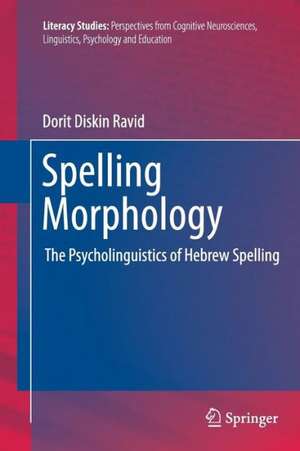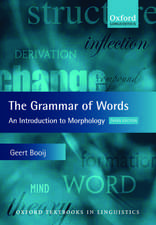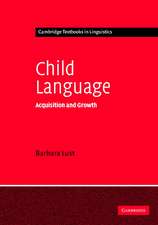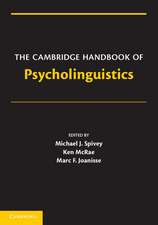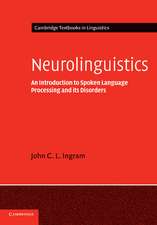Spelling Morphology: The Psycholinguistics of Hebrew Spelling: Literacy Studies, cartea 3
Autor Dorit Diskin Raviden Limba Engleză Paperback – 24 oct 2013
| Toate formatele și edițiile | Preț | Express |
|---|---|---|
| Paperback (1) | 635.65 lei 6-8 săpt. | |
| Springer Us – 24 oct 2013 | 635.65 lei 6-8 săpt. | |
| Hardback (1) | 641.85 lei 6-8 săpt. | |
| Springer Us – 31 aug 2011 | 641.85 lei 6-8 săpt. |
Din seria Literacy Studies
- 18%
 Preț: 955.25 lei
Preț: 955.25 lei - 18%
 Preț: 968.65 lei
Preț: 968.65 lei - 15%
 Preț: 645.47 lei
Preț: 645.47 lei - 5%
 Preț: 1100.85 lei
Preț: 1100.85 lei - 18%
 Preț: 886.40 lei
Preț: 886.40 lei - 15%
 Preț: 651.02 lei
Preț: 651.02 lei - 15%
 Preț: 640.88 lei
Preț: 640.88 lei - 18%
 Preț: 786.84 lei
Preț: 786.84 lei - 18%
 Preț: 954.45 lei
Preț: 954.45 lei - 15%
 Preț: 701.72 lei
Preț: 701.72 lei - 24%
 Preț: 802.74 lei
Preț: 802.74 lei - 15%
 Preț: 651.84 lei
Preț: 651.84 lei - 18%
 Preț: 890.68 lei
Preț: 890.68 lei - 18%
 Preț: 946.41 lei
Preț: 946.41 lei - 15%
 Preț: 638.57 lei
Preț: 638.57 lei - 18%
 Preț: 944.36 lei
Preț: 944.36 lei -
 Preț: 427.49 lei
Preț: 427.49 lei - 20%
 Preț: 620.45 lei
Preț: 620.45 lei - 18%
 Preț: 905.06 lei
Preț: 905.06 lei - 15%
 Preț: 639.41 lei
Preț: 639.41 lei - 20%
 Preț: 564.51 lei
Preț: 564.51 lei - 15%
 Preț: 637.93 lei
Preț: 637.93 lei - 15%
 Preț: 654.12 lei
Preț: 654.12 lei
Preț: 635.65 lei
Preț vechi: 747.82 lei
-15% Nou
Puncte Express: 953
Preț estimativ în valută:
121.63€ • 127.33$ • 100.64£
121.63€ • 127.33$ • 100.64£
Carte tipărită la comandă
Livrare economică 05-19 aprilie
Preluare comenzi: 021 569.72.76
Specificații
ISBN-13: 9781461429579
ISBN-10: 1461429579
Pagini: 200
Ilustrații: XII, 188 p.
Dimensiuni: 155 x 235 x 11 mm
Greutate: 0.29 kg
Ediția:2012
Editura: Springer Us
Colecția Springer
Seria Literacy Studies
Locul publicării:New York, NY, United States
ISBN-10: 1461429579
Pagini: 200
Ilustrații: XII, 188 p.
Dimensiuni: 155 x 235 x 11 mm
Greutate: 0.29 kg
Ediția:2012
Editura: Springer Us
Colecția Springer
Seria Literacy Studies
Locul publicării:New York, NY, United States
Public țintă
ResearchCuprins
Foreword .- Introduction: A Linguist’s Journey Towards Written Language .- Chapter 1: The Psycholinguistics of Spelling: Phonology and Beyond .- Chapter 2: Morphological Scaffolding in Learning to Spell: A Cross-linguistic Review .- Chapter 3: Spelling, Lexicon and Morphology .- Chapter 4: Historical and Sociolinguistic Perspectives on Hebrew .- Chapter 5: The Hebrew Phonology-orthographic Infrastructure .- Chapter 6: Morpho-orthographic Infrastructure .- Chapter 7: Root and Function Letters .- Chapter 8: The Phono-morpho-orthographic AHWY אהו"י Juncture .- Chapter 9: Spelling Cues in Nominals .- Chapter 10: Spelling Cues in Nominal Inflection .- Chapter 11: Spelling Cues in Verb Formation .- Chapter 12: Conclusion: The Psycholinguistics of Hebrew Spelling.- Subject index.
Notă biografică
Dorit Ravid is a linguist and psycholinguist working on the acquisition of Hebrew and the development of linguistic literacy at the School of Education and the Department of Communications Disorders, Tel Aviv University. She has published extensively on early and later language acquisition in Hebrew and Arabic, the nature of spelling acquisition, the development of discourse production abilities, and on language learning in special populations.
Textul de pe ultima copertă
Modern Hebrew is a highly synthetic Semitic language—its lexicon is rich in morphemes. This volume supplies the first in-depth psycholinguistic analysis of the interaction between morphological knowledge and spelling in Hebrew. It also examines how far this model can be applied to other languages. Anchored to a connectionist, cognitive, cross-linguistic and typological framework, the study accords with today’s perception of spelling as being much more than a mere technical skill. Contemporary psycholinguistic literature views spelling as a window on what people know about words and their structure. The strong correlation between orthographies and morphological units makes linking consistent grammatical and lexical representation and spelling units in speaker-writers a key research goal. Hebrew’s wealth of morphological structures, reflected in its written form, promotes morphological perception and strategies in those who speak and write it, adding vitality and relevance to this work.
Caracteristici
No book has ever been written about spelling acquisition in Hebrew Provides the most comprehensive and detailed model linguistically-based of Hebrew orthography Integrates, for the first time, linguistic insights and developmental psycholinguistic evidence for the acquisition of spelling Will serve as an indispensable guide for students, scholars, and practitioners in learning about Hebrew spelling and morphology in development
